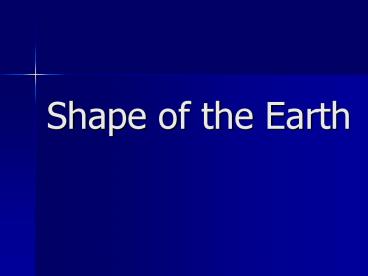Shape of the Earth PowerPoint PPT Presentation
1 / 29
Title: Shape of the Earth
1
Shape of the Earth
2
The actual shape of the Earth is an Oblate
Spheroid
3
the earth is slightly flattened at the poles and
bulging at the equator
4
Therefore the equatorial diameter is larger
5
(No Transcript)
6
The Earth is very slightly oblate about a 43km
difference between the polar and equatorial
diameters
7
The Earth appears to look like a sphere from space
8
The gravitational pull is greater at the Poles
than the Equator. This is because at the Poles
you are closer to the center of the earth.
9
Evidences of Earths Shape
10
Eclipses Shadow of the earth is cast upon the
moon in a lunar eclipse
11
Large Objects on the Horizon Objects disappear
bottom up and Objects appear top down
12
Photographs from Space Best evidence of
shape
13
Polaris(North Star)The Altitude ofPolaris in
the SkyIs Equal to your Latitude
14
Solid Earth System
15
The Earth is like an onion, it is made up of many
layers. Although we have not been to the center
of the Earth, Earthquakes, and volcanoes tell us
a lot about its interior. The deepest man has
dug into the Earth is 5 km in the South Africa
gold mines. Here the temperature increases by 10
to 15 C for every kilometer down.
16
HYDROSPHERE
THE LAYER OF LIQUID WATER THAT LIES BETWEEN THE
ATMOSPHERE AND MOST OF THE LITHOSPHERE
COVERS 71 OF THE EARTHS SURFACE AVE 3.8 KM IN
THICKNESS MOSTLY HYDROGEN AND OXYGEN
17
The interior of the Earth
- The Earth is divide into 3 concentric layers
- The crust
- The Mantle
- The core
- Each layer has different properties
18
More about the layers
- The difference between the mantle and the crust
is based on chemical composition. - The difference between the asthenosphere and the
lithosphere is based on viscosity (the ability to
flow under pressure.)
19
The crust
The crust is a very thin skin which surrounds the
planet There are two types of crust Oceanic
crust which is thin (7 km) and is made up of
dense volcanic rock (basalt) Continental crust
is thick ( 35 km) and is less dense than
oceanic crust. It is rich in quartz and
feldspar. It is thicker under mountains.
20
The Lithosphere
The crust and the upper part of mantle form the
Lithosphere. It is fragmented into a series of
segments called plates. These plates move with
respect to each other and are the cause of most
Earthquakes and volcanoes. The lithosphere is
usually 100 km thick
21
(No Transcript)
22
The Mantle
It is between the crust and the core. It is
mainly solid, but acts as a fluid-like solid.
The upper part of the mantle is cooler and so
stronger. This strong part of the mantle is
joined together with the crust to form the
lithosphere. It goes down to 1300C The mantle
which directly underlies the lithosphere is much
hotter and so weaker, this is called the
Asthenosphere. (astheno means weak) it goes down
to 1700 C The lithosphere slides over the
Asthenosphere The area below the this is called
the lower mantle
23
Convection currents in the mantle We think the
mantle acts like hot and sticky tar. It is heated
by the core below it and cooled by the crust
above. When you heat a fluid its density drops
and it expands. If you cool it, it will contract
and become more dense. So the hotter material at
the base rises toward the top while the cooler
material at the top sinks. This generates slowly
flowing convection currents in the Mantle
24
(No Transcript)
25
The Core
- The core is divided into two parts outer core
which is liquid inner core which is solid - The core is made up of mainly iron and nickel
which makes it very dense - The movement of the liquid outer core generates
the Earths magnetic field
26
The interior of the Earth has a major impact on
other Earth systems.
- Convection currents in the mantle cause the
movement of the plates - The internal heat is responsible for volcanoes.
- The outer core generates the Earths magnetic
field - Earths early atmosphere and water was probably
formed from volcanic gases derived from inside
the Earth. - The position of the continents effects ocean
currents and so the Earths climate. - Plates also effect the geographic distribution of
organisms and so their evolution
27
(No Transcript)
28
What is the solid Earth Made of?
Planet Earth is a rocky planet. It is made up of
rocks and minerals. The Earth is made up of a
number of Elements The interior of the Earth is
quite different than the exterior (continental
crust)
29
How do we know?
- What evidence do we really have that the interior
of the earth is the way we think it is? - Deep mines are hot!
- Heat and molten material escape from volcanos and
geysers. - Earthquake waves

